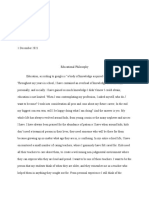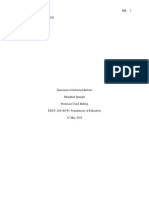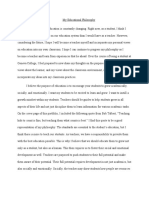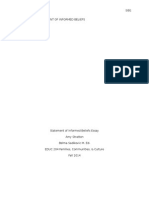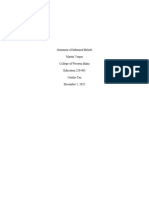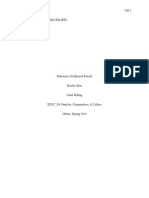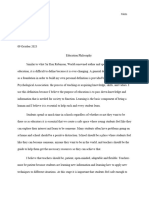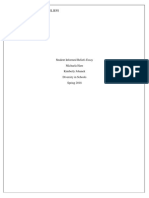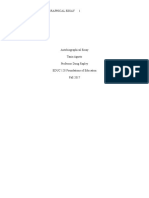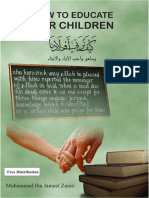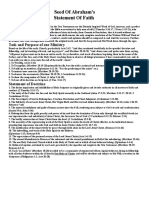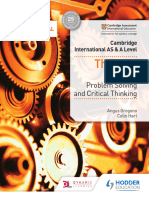Final Sib Full Asignment
Final Sib Full Asignment
Uploaded by
api-511926002Copyright:
Available Formats
Final Sib Full Asignment
Final Sib Full Asignment
Uploaded by
api-511926002Original Title
Copyright
Available Formats
Share this document
Did you find this document useful?
Is this content inappropriate?
Copyright:
Available Formats
Final Sib Full Asignment
Final Sib Full Asignment
Uploaded by
api-511926002Copyright:
Available Formats
Running head: STATEMENT OF INFORMED BELIEFS 1
Statement of Informed Beliefs Essay
Tania Agurto
Doug Rapley
EDUC 220
Fall 2017
STATEMENT OF INFORMED BELIEFS 2
Statement of Informed Beliefs Essay
Education, is a single word and nevertheless it covers so much. Each child is a world,
ways of thinking and learning that are different and converge in a classroom. Different realities
and challenges. What great responsibility as future teachers we have to teach each one of them
giving the best of us, our best effort.
In the following paragraphs I will make my dreams known, my thoughts regarding the
expectations I have about Education. The essay will be divided into five sections that are: All
Students Can Learn, Teacher’s Expectations, Students’ Social Ecology Theory, Cultural Diversity
Instruction and Curriculum for all Learners
All Students Can Learn
When I was studying at university, I had a teacher, Professor Ortiz, who always said "a
good student learns despite the teacher". His phrase discouraged me every time I listened to it,
because I felt that I had full responsibility for my learning process, even when I did not know
anything.
Over time I have learned that each person has a potential to develop. Sometimes it is in
sight and sometimes not, sometimes even unknown by the person who owns it. I firmly believe
that one of the teacher’s duties is to help to discover, develop and also enhance it. Nevertheless,
how can we reach each of our students if each person is a different world? It’s a very difficult
and demanding task. I think that observation must be an ability to develop, as well as empathy.
As we take time to meet our students then our task of seeing their potential and helping to
develop it will be much simpler. If we observe with sufficient detail, then we will find the best
teaching methodologies that will help our children.
STATEMENT OF INFORMED BELIEFS 3
Regarding to leadership I received a teaching that I consider powerful and therefore I
treasure as something that would help me all my life. Someone told me that a good leader knows
how to delegate tasks and then verify them. That’s what I think a good teacher should do. Allow
their students to be an active part of their learning, delegating tasks to them and verifying that
they can fulfill them, as well as recognizing the work and effort they put in their assignment.
When I think of my future students, I try to remember what I would have liked to receive myself
as a student, I believe that this is a good exercise in getting closer to them and attaining the
expected learning.
Teacher’s Expectations
I have always thought that a good teacher can change the life of a child. Many times, the
work of the teacher is not valued, it is not given the importance it has. However, the good
influence of a teacher can install valuable ideas in student minds, therefore it is pretty important
the teacher's expectations about what his/her students can achieve and what the teacher can do in
order to support the students to reach their potential.
What do we mean by the teacher's expectations? Reflecting on that I think what should a
teacher expect from a student? Many of the teachers I have met expect them to behave in the
classroom, to participate in classes and learn. I think those are good things to expect, but I ask
myself again, is that enough? I think that expecting only that from the students is not to value
them sufficient. From my personal point of view, I think that expecting them to develop critical
thinking is very satisfying, because it is one of the most useful tools that students could cultivate
as a learning for life.
I intimately believe that what one expects has a direct relationship with vocation. When
we study what we are really passionate about, we think of giving our best in order to perform in
STATEMENT OF INFORMED BELIEFS 4
the best possible way, because we are enjoying what we do, because that fills our life. That is the
key of everything. Being a teacher is more than just deliver content, it is more than assessment
it is more than reaching certain standards. A teacher needs to go beyond to do his/her work well,
he/she needs to know the background of each student, to know about his/her microsystem to see
what their interests are, to realize what is the best way to teach each one. Besides it is the other
part of being a teacher, which has nothing to do with knowledge but with the heart. The teacher
should be able to have his/her students trust, to see him/her as someone to trust any problem and
in this way the teacher can install in the mind and in the heart of the student the idea that he or
she can achieve his/her best version, no matter their circumstances, their country or their
ethnicity because we all have a potential to develop…. It is not easy to be a teacher, but it fills
the soul.
When we talk about what a teacher expects from students, I relate it immediately to the goals that
the teacher has set out to help students to cope with expectations. I wonder, is the planning
important? Are the objectives important? of course yes! Long time ago I learned that we must set
goals to achieve objectives, and that those goals must be written and must have date to verify
progress. Not long ago I learned that the goals that we draw must be intelligent and achievable,
one step at a time. That is the way to work, plan smart. Without proper planning for each class it
is impossible to achieve goals for our children to progress. Planning is one of the foundations of
work as a teacher. Planning and organization are fundamental to be a good teacher.
Students’ Social Ecology Theory
On repeated occasions I have asked myself what should be done to motivate a child to
want to learn. It is difficult to think that with all the opportunities that exist today, someone does
not feel encouraged to dream with what he wants to be.
STATEMENT OF INFORMED BELIEFS 5
All the above makes me think about the importance of connecting learning with the social
environment of our students. Is it important that, as teachers, we know their social environment,
their ideas, their hobbies, their reality? My answer is, absolutely yes! Why? Simply, because we
want them to learn, we want them to discover themselves, we want them to let themselves dream
that they can be whatever they want to be. I think that if they feel their reality identified in some
proportion in some content they are learning, they will not feel so distinct and that will make
their learning meaningful.
Does the social environment have an impact on a student's learning? Of course, yes. The
support, or on the contrary, the discouragement of a family towards a child can powerfully
influence their learning, above all their motivation to progress and improve. Also, the cultural
influence is important. In places where there is no equality of gender for example, we can hardly
see a young girl opening her way to be a professional, independent in all areas of her life. I
imagine, and I pray because there are exceptions in these cases.
Such as there are ways to encourage a child, there are also ways to slow down their
progress, most of the time it will be their environment and the reality they experience that does
not allow them to believe that they can achieve their dreams, but as long as they walk in a
classroom should be the teacher who makes them feel that despite the difficulties involved in
achieving what they want, they can.
Cultural Diversity Instruction
At the time when I was attending school in Chile there was not massive immigration yet
as it happens today, it was difficult and even strange to have a classmate from another country.
Today the scenario is totally different, even in some schools in Santiago specific areas there are
more immigrant children than Chilean children. Haitians, Colombians, Peruvians and now more
STATEMENT OF INFORMED BELIEFS 6
and more commonly Venezuelans children fill the classrooms, light up and paint our schools in
colors, it's a wonderful cultural exchange!
As a student, I would have loved to know, even if it was a bit of other cultures and
realities, and in that way, expand my vision of life. I imagine that as a teacher it should be a good
and at the same time challenging experience to have students of different nationalities and
cultural backgrounds in a classroom. There is a lot of work that must be done to cover all the
needs that this may require. From the identification of academic and cognitive conditions to the
support at the human level for these children, passing of course for the prevention of unwanted
bullying. I think that allow to take time from obligatory curriculum to perform activities that
permit children to know their peers, their life stories, their dreams, their expectations could bring
them closer as classmates and even generate friendships that are always important to achieve
integration. Feedback. Learning for everybody.
However, what would be more optimal for immigrant children? Cultural Pluralism or
Cultural Assimilation? What would allow them to feel integrated in a new country? Let’s
analyze both. Cultural Pluralism points to the sociocultural diversity, the differences are
respected, and they are seen as a wealth for the country that receives that new influence, it is a
contribution. However, by maintaining all their cultural traditions and language sometimes
they fail to incorporate themselves adequately and generate difficulties in their daily lives.
Cultural Assimilation points to the process of integration to a dominant culture in which the
culture is lost partially or sometimes totally in the group that is integrated. What is the
disadvantage? Loss of identity. When I arrived here, I was able to observe this in the Hispanic
community. I must admit that it is sad for me to see little children of Latino parents who speak
absolutely nothing of Spanish. Could we say then that they joined the country because they know
STATEMENT OF INFORMED BELIEFS 7
its language perfectly? I would say no. Many times, they seem to feel no place, neither from
here, nor from there. And what do we do then to integrate them? the change should not only
occur in them but in the whole society. Going back to the previous thing, I believe that there
must be a balance in both tendencies. When immigrating to another country, those who arrive
must incorporate themselves in the best way to this culture that receives them, but also those who
arrive have something to contribute. Soaking up this new culture without forgetting the roots,
without losing the identity, because we all have something valuable to contribute.
Curriculum for all Learners
I used to think that curriculum was the content of each subject determined for each grade,
but at the end of my first semester of Education classes I realized that I was wrong, what I mean,
my concept was incomplete. Ryan, Cooper and Bolick point out:
We define the curriculum as all organized and intended experiences of the student for which the
school accepts responsibility. In other words, the curriculum is not just the intellectual content of
the subjects taught but also the methods used to teach them, the interactions that occur among
people, and the school-sponsored activities that contribute to the “life experience”. (118)
The curriculum has a much broader spectrum than I imagined, that makes me reflect on
how important is the effective planning of the contents and activities to be developed with the
students, but also on the ability to make adjustments if necessary, depending on the reality of
each class. Personally, I will make changes based on how the students are learning, reviewing
when needed, checking comprehension, while keeping in mind that all the students come with
different skill sets and backgrounds, and by trying to make learning personal.
However, one part is the curriculum and planning, and another is the implementation of the
planned contents. Achieving these contents in an effective way is something complex many
STATEMENT OF INFORMED BELIEFS 8
times, that means teachers must give the best of them to achieve this goal. Berns declares:
“Teachers who try to work closely with each child and who understand group dynamics are more
likely to provide a successful and rewarding learning environment”. (218) If a teacher delivers
the planned content thinking of each class and assess students periodically, formally and
informally we are able to improve planning and delivery so as to not waste time on contents
already mastered and focus on those items that the students are struggling with and as a result we
can achieve meaningful learning and at the same time a student progress overview.
Undoubtedly being a teacher is a challenging profession, full of daily goals to achieve,
but see the progress of each student is the best reward.
Conclusion
This work has been of great learning for me, since I have been able to discover myself
and delve into what I believe and dream.
Without a doubt, becoming a teacher in a world that is constantly changing is not easy,
but it is challenging and worth trying. I understand that my accountability as a teacher will be
really important in this process not only of learning, but also of training persons as well.
Nowadays I have a broader spectrum of the current world, cultural exchange and the challenges
that teaching entails.
STATEMENT OF INFORMED BELIEFS 9
References
Berns, R. (2013). Child, family, school, community: socialization and support. Australia:
Wadsworth, Cengage Learning.
Ryan, K., Cooper, J. M., & Bolick, C. M. (2016). Those who can, teach. Australia: Cengage
Learning.
You might also like
- My Own Educational PhilosophyDocument2 pagesMy Own Educational PhilosophyElia Kim FababeirNo ratings yet
- English Language Exam - A2-B1Document10 pagesEnglish Language Exam - A2-B1dule8350% (2)
- Bouyguestelecom Facture 20161113Document8 pagesBouyguestelecom Facture 20161113Malick DiattaNo ratings yet
- Portfolio Project 12Document3 pagesPortfolio Project 12api-583142684No ratings yet
- Educ 204 Sib FinalDocument8 pagesEduc 204 Sib Finalapi-212910272No ratings yet
- Progressivism and The Good TeacherDocument5 pagesProgressivism and The Good TeacherChlea Marie Tañedo AbucejoNo ratings yet
- Running Head: Statement of Informed Beliefs 1Document11 pagesRunning Head: Statement of Informed Beliefs 1api-434513463No ratings yet
- Philosophy of EducationDocument1 pagePhilosophy of Educationapi-503006368No ratings yet
- Autobiography EssayDocument7 pagesAutobiography Essayapi-533899699No ratings yet
- Artifact 3Document5 pagesArtifact 3api-644796235No ratings yet
- Statement of Informed BeliefsDocument7 pagesStatement of Informed Beliefsapi-294499864No ratings yet
- SibDocument7 pagesSibapi-285520832No ratings yet
- Statement of Informed Beliefs 1Document8 pagesStatement of Informed Beliefs 1api-356392276No ratings yet
- Philosophy of Education PaperDocument7 pagesPhilosophy of Education Paperapi-252997142No ratings yet
- Statement of Informed BeliefsDocument7 pagesStatement of Informed Beliefsapi-340864716No ratings yet
- Running Head: Statement of Informed Beliefs 1Document8 pagesRunning Head: Statement of Informed Beliefs 1api-356549962No ratings yet
- Educ-204-Final SibDocument8 pagesEduc-204-Final Sibapi-356995658No ratings yet
- Artifact 1 - My Educational PhilosophyDocument7 pagesArtifact 1 - My Educational Philosophyapi-550019058No ratings yet
- Portfolio Educational PhilosophyDocument3 pagesPortfolio Educational Philosophyapi-507434783No ratings yet
- Statement of Informed Beliefs Essay JD Tarbet Carol Billing EDUC 204 Families, Communities, & Culture Fall 2016Document9 pagesStatement of Informed Beliefs Essay JD Tarbet Carol Billing EDUC 204 Families, Communities, & Culture Fall 2016api-356705303No ratings yet
- BEED IV BLOCK 10. EXIA ARCHIE M. 3000 WORDS-WPS OfficeDocument13 pagesBEED IV BLOCK 10. EXIA ARCHIE M. 3000 WORDS-WPS OfficeArchie Mariñas ExiaNo ratings yet
- Sib1 Running Head: Statement of Informed BeliefsDocument9 pagesSib1 Running Head: Statement of Informed Beliefsapi-283801172No ratings yet
- Statement of Informed BeliefsDocument9 pagesStatement of Informed Beliefsapi-576887653No ratings yet
- Sib Final DraftDocument9 pagesSib Final Draftapi-284217834No ratings yet
- Ued 496 Crankshaw Brittany Teaching PhilosophyDocument5 pagesUed 496 Crankshaw Brittany Teaching Philosophyapi-337433583No ratings yet
- My Personal Philosophy of EducationDocument3 pagesMy Personal Philosophy of EducationMelchor del RosarioNo ratings yet
- Karayom". It Seemed Funny But That Is The Truth. Since Then, I Feel That I Am VeryDocument4 pagesKarayom". It Seemed Funny But That Is The Truth. Since Then, I Feel That I Am VeryQuennie Zendy C. AquinoNo ratings yet
- Statement of Informed BeliefsDocument12 pagesStatement of Informed Beliefsapi-529995508No ratings yet
- Statement of Informed BeliefsDocument7 pagesStatement of Informed Beliefsapi-435023769No ratings yet
- Annotated-Artifact 20 233 20 - 20google 20docsDocument5 pagesAnnotated-Artifact 20 233 20 - 20google 20docsapi-609659131No ratings yet
- Statement of Informed Beliefs EssayDocument9 pagesStatement of Informed Beliefs Essayapi-678668869No ratings yet
- Abecassandrahernandezfa 22Document7 pagesAbecassandrahernandezfa 22api-679365507No ratings yet
- Entre Regional Des Metiers de LDocument7 pagesEntre Regional Des Metiers de LFadwaRhimiNo ratings yet
- Philosophy of EducationDocument7 pagesPhilosophy of Educationapi-288966220No ratings yet
- Principles of Leadership-Panganiban Nikka C. (Updated)Document5 pagesPrinciples of Leadership-Panganiban Nikka C. (Updated)Nikka Cedeño PanganibanNo ratings yet
- Sib FinalDocument7 pagesSib Finalapi-404803522No ratings yet
- Teaching_Philosophy_Statements_Document5 pagesTeaching_Philosophy_Statements_Ahmad A. JawadNo ratings yet
- Philosophy Statement of EducationDocument4 pagesPhilosophy Statement of Educationapi-257343862No ratings yet
- Teaching PhilosphyDocument4 pagesTeaching Philosphyapi-710776183No ratings yet
- Sib AssignmentDocument7 pagesSib Assignmentapi-415905015No ratings yet
- Creating A Culturally Relevant ClassroomDocument9 pagesCreating A Culturally Relevant ClassroomFMConnaghanNo ratings yet
- Philosophy of Education Paper Draft 3-1Document5 pagesPhilosophy of Education Paper Draft 3-1api-252993313No ratings yet
- Edu201 PersonalphilosophyofeducationDocument4 pagesEdu201 Personalphilosophyofeducationapi-371352151No ratings yet
- Educational PhilosophyDocument3 pagesEducational Philosophyapi-449648328100% (1)
- Running Head: Statement of Informed Beliefs 1Document8 pagesRunning Head: Statement of Informed Beliefs 1api-302824987No ratings yet
- Philo and Psycho-Socio Found of Education - Ivy Lorein LariosaDocument19 pagesPhilo and Psycho-Socio Found of Education - Ivy Lorein LariosaIvy Lorein LariosaNo ratings yet
- Sib 5 FidanzaDocument10 pagesSib 5 Fidanzaapi-383622059No ratings yet
- My Educational PhilosophyDocument2 pagesMy Educational Philosophyapi-547598848No ratings yet
- Philosophy of EducationDocument4 pagesPhilosophy of Educationapi-459081643No ratings yet
- My Personal Philosophy of EducationDocument7 pagesMy Personal Philosophy of Educationapi-250901151100% (1)
- Untitled Document 6Document2 pagesUntitled Document 6api-690000598No ratings yet
- Personal Philosophy of EducationDocument10 pagesPersonal Philosophy of Educationapi-249704153No ratings yet
- Sib Essay 1Document12 pagesSib Essay 1api-744988181No ratings yet
- SibessayfinalmayganhDocument8 pagesSibessayfinalmayganhapi-384958380No ratings yet
- Water It and It Will Grow My Philosphy of Education RevisedDocument5 pagesWater It and It Will Grow My Philosphy of Education Revisedapi-506285139No ratings yet
- Jenesa Mae J. Yaco Educ.2 Activity Lesson 2Document8 pagesJenesa Mae J. Yaco Educ.2 Activity Lesson 2Jenesa XiNo ratings yet
- Ued495-496 Rowan Colleen Personal Philosophy of EducationDocument5 pagesUed495-496 Rowan Colleen Personal Philosophy of Educationapi-306447547No ratings yet
- Final SibDocument13 pagesFinal Sibapi-416199376No ratings yet
- Edu 202 Artifact 1 - Philosphy of EducationDocument5 pagesEdu 202 Artifact 1 - Philosphy of Educationapi-564717621No ratings yet
- Artifact 1 Educational PhiloshopyDocument5 pagesArtifact 1 Educational Philoshopyapi-635562745No ratings yet
- Personal Philosophy of Education: Hoey 1Document11 pagesPersonal Philosophy of Education: Hoey 1api-295261080No ratings yet
- Teaching Heart to Heart:: A Book of Reflections and Encouragement for TeachersFrom EverandTeaching Heart to Heart:: A Book of Reflections and Encouragement for TeachersNo ratings yet
- Teaching PhilosophyDocument1 pageTeaching Philosophyapi-511926002No ratings yet
- Idsp Final Paper The Last OneDocument7 pagesIdsp Final Paper The Last Oneapi-511926002No ratings yet
- Autobiographical Essay FinalDocument7 pagesAutobiographical Essay Finalapi-511926002No ratings yet
- Tania Ivon Agurto: ExperienceDocument2 pagesTania Ivon Agurto: Experienceapi-511926002No ratings yet
- Lesson Plan: Legislative PDFDocument2 pagesLesson Plan: Legislative PDFapi-511926002No ratings yet
- Japan 1Document8 pagesJapan 1api-511926002No ratings yet
- Narrative Report MILDocument6 pagesNarrative Report MILRhenz MahilumNo ratings yet
- 1BAT Summer Homework 2015Document4 pages1BAT Summer Homework 2015Classreus Harry CallaghanNo ratings yet
- Sagar Cements Limited: SCL:SEC:NSE:BSE:2018-19Document141 pagesSagar Cements Limited: SCL:SEC:NSE:BSE:2018-19Pavan kalyan UramduruNo ratings yet
- How To Educate Our Children Muhammad Ibn Jamil ZinoDocument135 pagesHow To Educate Our Children Muhammad Ibn Jamil Zinobaseer abdulNo ratings yet
- Math 3u - Estimating DifferenceDocument16 pagesMath 3u - Estimating DifferenceZL TenorioNo ratings yet
- XXVII Brazilian Congress On Biomedical EngineeringDocument12 pagesXXVII Brazilian Congress On Biomedical Engineeringmayco.andersonNo ratings yet
- M1831379a 40K Doubles ScenariosDocument6 pagesM1831379a 40K Doubles ScenariosLiam CaponNo ratings yet
- Determinants of Learning Learning ReadinessDocument7 pagesDeterminants of Learning Learning ReadinessHNo ratings yet
- VIP English Teaching Service Agreement - Filipino Teachers - MR - LegoDocument9 pagesVIP English Teaching Service Agreement - Filipino Teachers - MR - LegoEugene LegoNo ratings yet
- Mining in BoliviaDocument53 pagesMining in BoliviaOsvaldo ArceNo ratings yet
- Reteta p2pDocument2 pagesReteta p2pJohn JohnNo ratings yet
- SWOT AnalysisDocument3 pagesSWOT AnalysisKHURAM AHMER0% (1)
- 18th Century As A Period of TransitionDocument5 pages18th Century As A Period of TransitionAshwini Rai0% (1)
- Broadway BlanketDocument18 pagesBroadway Blanketcnovarese100% (1)
- Tick Live DataDocument10,818 pagesTick Live DataAnnaAmey7749No ratings yet
- TPE 331 EvolutionDocument7 pagesTPE 331 Evolutionjohn kasich100% (1)
- Statement of FaithDocument1 pageStatement of Faithapi-328094478No ratings yet
- Building Brand Infosys-Group 8Document4 pagesBuilding Brand Infosys-Group 8Sauhard GuptaNo ratings yet
- EPF New HQ (Kwasa Damansara)Document5 pagesEPF New HQ (Kwasa Damansara)Winnie YeeNo ratings yet
- Swivelpole-Catalogue-GlobalDocument12 pagesSwivelpole-Catalogue-GlobalGustavNo ratings yet
- Anson Mills Wholesale Products 2019Document5 pagesAnson Mills Wholesale Products 2019jikson26No ratings yet
- Breeding Management of Cattle and BuffaloesDocument69 pagesBreeding Management of Cattle and BuffaloesJigar PatelNo ratings yet
- PRC Application Form Without ExamDocument2 pagesPRC Application Form Without Examdaniel.cabasa2577100% (1)
- President ElectionDocument12 pagesPresident Electionsahil khanNo ratings yet
- Al Thinking Skills Sample WebDocument24 pagesAl Thinking Skills Sample WebHasini ImmandiNo ratings yet
- Microsoft Power BI DIADDocument85 pagesMicrosoft Power BI DIADsharukh100% (1)
- NosferatuDocument117 pagesNosferatuOrhun BaşerNo ratings yet
- JDG BüchnerDocument25 pagesJDG Büchnerdana ANo ratings yet



